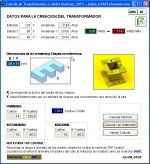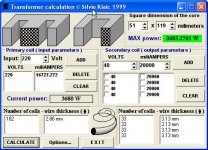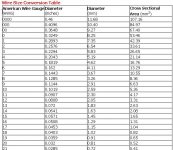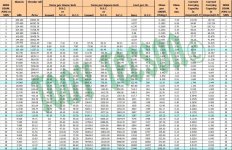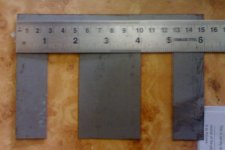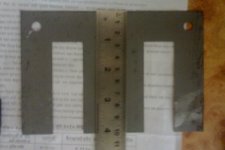Hi,
the left pic must be wrong.
Those X & Y dimensions must be about a factor of 10 in error.
Could it be he has his mm and cm mixed up?
The middle pic seems to be right I have used it to estimate EI transformers I have bought secondhand or inside existing equipment. One part missing from Klaic' software is choosing the working flux.
the left pic must be wrong.
Those X & Y dimensions must be about a factor of 10 in error.
Could it be he has his mm and cm mixed up?
The middle pic seems to be right I have used it to estimate EI transformers I have bought secondhand or inside existing equipment. One part missing from Klaic' software is choosing the working flux.
hi tony,
is this softwares perfect?
what is cross section in awg table?
the picture on the left must be in cm not mm as shown, otherwise the calculations are okay.......
cross-section area = (2pi x diam)/4 = (6.28 x diam.)/4, it forms basis for current density in your copper, i am used to imperial units, i use 500 or 700 cm per ampere current density. the ARRL handbook has this nice table to look at...
Attachments
Last edited:
sir Tony, I have this CRGO core, and size u can see,
can u tell me about winding to get 80-40-0-40-80volts at25 amp?
Thank u
have you done traffo winding before?
San,
using the 40+40Vac windings as the 25Aac you require 2kVA from the transformer.
The 2" core stacked to 3" thick gives 6sq" of core area.
That equates to ~1100VA. Well short of 25Aac @ 40+40Vac.
12Aac for the 40Vac windings and 7Aac for the extra 40Vac windings would seem to be in the ball park.
I think that is why Tony asked
using the 40+40Vac windings as the 25Aac you require 2kVA from the transformer.
The 2" core stacked to 3" thick gives 6sq" of core area.
That equates to ~1100VA. Well short of 25Aac @ 40+40Vac.
12Aac for the 40Vac windings and 7Aac for the extra 40Vac windings would seem to be in the ball park.
I think that is why Tony asked
have you done traffo winding before?
sir Tony, I have this CRGO core, and size u can see,
can u tell me about winding to get 80-40-0-40-80volts at25 amp?
Thank u
Short answer: yes. (IF you have a stack 3 inches high, giving 6 square inches of core, which is reasonable.)
You will need to wind the primary with 80 turns of 9 awg wire (80 turns for 1.2 T and 120vac, 60 cycles), and for the secondary you will need 10 awg wire, 4 x 26 turns.
This isn't something that will be easy. you will need to machine an aluminium block to wind the wire on, because wood or plastic will be crushed under the stress. I would recommend after winding the coils, wrap the core in Kapton tape, slip the coil on the core and fill it with epoxy.
Both primary and secondary will dissipate about 30 watts each for a 2kw resistive load. Capacitive input filters require 1.5-2 times KVA as Watts, keep that in mind.
you may have to run the core a little hotter at 1.3 T, and use 70 turns of 8 AWG wire for the primary.
Either way, you're looking at 3.8 kilograms of copper.
I would wind the 4 secondaries over the top of each other in 4 single layers, each set of 26 turns will stretch 70-72mm across, giving you a 1-2 mm gap between the core and the coil. (ever open up a microwave oven transformer? -that's normal)
you'll then be left with plenty of space for the primary, which is going to dissipate most of the heat if you can't find 9 awg wire and you have to use 10 awg.
Last edited:
Don't get this.
When I look at Sandeep's pictures we deal with an EI 150 core.
Standard stacking heights for this core (with respect to available bobbins) are 4.79 cm, 6.49 cm and 9.09 cm.
Presuming good quality core material of 0.35 mm strip thickness secondary power for these cores are 560, 730 and 940 watts respectively.
Afe (effective core area) 22.2, 30.1 and 42.1 cm² respectively.
Please note that effective core area is less than stacking height x tongue width.
Number of primary turns for 1.2 T and 220 VAC/50Hz 370, 275 and 195 respectively.
I did not check currents (with respect to wire diameters).
When I look at Sandeep's pictures we deal with an EI 150 core.
Standard stacking heights for this core (with respect to available bobbins) are 4.79 cm, 6.49 cm and 9.09 cm.
Presuming good quality core material of 0.35 mm strip thickness secondary power for these cores are 560, 730 and 940 watts respectively.
Afe (effective core area) 22.2, 30.1 and 42.1 cm² respectively.
Please note that effective core area is less than stacking height x tongue width.
Number of primary turns for 1.2 T and 220 VAC/50Hz 370, 275 and 195 respectively.
I did not check currents (with respect to wire diameters).
Last edited:
^the width of the lamination is 6 inches in the drawing therefore the tounge width is 2 inches....
stacked to 4 inches and you get a core with 8 square inches, stacking factor of 95% gives you a core area of 7.6
as per RDH3 you can get a core VA of 1796.......
for a voltage input of 230 volts, 60hz. primary turns is 226, #15 AWG, secondary 4 coils wound bifiliar x 2 at 40 turns #13 AWG..
you can wind secondary 2 coils bifilar, after which another bifilar.....or you can do a quadfilar wiind.....
take note that wire gauge in India follows the British standard, whereas in Manila we use the American standard, so your wires should have the same diameter as i quoted.
stacked to 4 inches and you get a core with 8 square inches, stacking factor of 95% gives you a core area of 7.6
as per RDH3 you can get a core VA of 1796.......
for a voltage input of 230 volts, 60hz. primary turns is 226, #15 AWG, secondary 4 coils wound bifiliar x 2 at 40 turns #13 AWG..
you can wind secondary 2 coils bifilar, after which another bifilar.....or you can do a quadfilar wiind.....
take note that wire gauge in India follows the British standard, whereas in Manila we use the American standard, so your wires should have the same diameter as i quoted.
Don't get this.
When I look at Sandeep's pictures we deal with an EI 150 core.
Standard stacking heights for this core (with respect to available bobbins) are 4.79 cm, 6.49 cm and 9.09 cm.
Presuming good quality core material of 0.35 mm strip thickness secondary power for these cores are 560, 730 and 940 watts respectively.
Afe (effective core area) 22.2, 30.1 and 42.1 cm² respectively.
Please note that effective core area is less than stacking height x tongue width.
Number of primary turns for 1.2 T and 220 VAC/50Hz 370, 275 and 195 respectively.
I did not check currents (with respect to wire diameters).
I should have assumed he was on 50Hz, in any case, that takes the "rated" kva down another 16%^2.
I've always assumed that actual core area was 98% of theoretical, and that 2% reduction doesn't really matter. (I included that 2% in my spreadsheet btw.)
so, here's some new numbers:
Assuming core area is 50mm by 90mm giving an actual core area of 4410mm^2.
At 1.2T and 50Hz that's 204 turns.
Assuming that the bobbin is 2mm thick on all 4 sides, this cuts the window area down to 657 mm^2 x 2.
This means for 69% fill, the primary will be (1) 14 awg winding, and the secondary would be (1) 12 awg winding for a 74% fill.
Assuming 40 watts lost for the core, then its possible to pull 1.2 kva from the transformer for a copper loss of ~40 watts.
(93% efficient)
Assuming that he don't use a bobbin, and can wind the wire on a machined aluminium block and get a 1mm gap between the winding and the core, and he can run the transformer at 1.3T
Then its entirely appropriate to wind the primary with one coil of 12 awg wire (189t) and the secondary with 2 x 14 awg wire.
Assuming the core and copper loss is now 50 watts, pulling 1.6 KVA from the transformer would get you a 94% efficient transformer.
The question is, is 100 watts reasonable losses?
^the width of the lamination is 6 inches in the drawing therefore the tounge width is 2 inches....
stacked to 4 inches and you get a core with 8 square inches, stacking factor of 95% gives you a core area of 7.6
as per RDH3 you can get a core VA of 1796.......
for a voltage input of 230 volts, 60hz. primary turns is 226, #15 AWG, secondary 4 coils wound bifiliar x 2 at 40 turns #13 AWG..
8 square inches would require only 90 turns for 1.2T and 240vac, with a 2mm thick bobbin, 10 awg wire would fit just fine.
edit: my bad, read that as a 8 inch stack...
in anycase, that's 181 turns.
226 turns would take the excition down to 0.9T
Last edited:
8 square inches would require only 90 turns for 1.2T and 240vac, with a 2mm thick bobbin, 10 awg wire would fit just fine.
i build my traffos at less than 1T....
- Home
- Amplifiers
- Power Supplies
- Tony's latest traffo DIY build
